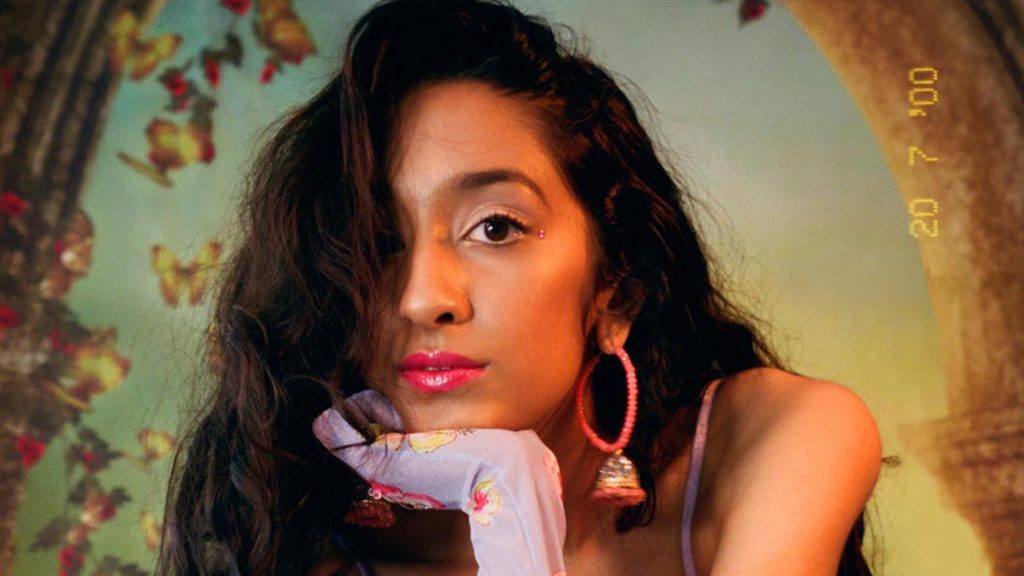
Baby’s All Right was filling up fast on a late July night this past summer. The Brooklyn venue was buzzing with excitement early on, with people filing in and heading to the bar in the back to get a drink before the opener came on stage. Everyone was gathered for Raveena, a New York native who had made a name for herself with her soothing voice and ethereal image. Her songs are melodic and serene, with steady percussion and synth, and instrumentals that sound like something out of a dream.
The dreamlike quality of Raveena’s music extends to the visual image she portrays of her tunes and herself. Her music videos contain a multitude of flowers, delicate and solid colors, and a hazy focus on the models. They reflect a desire to promote softness and sensuality. This visual image also attempts to be inclusive, with a focus on creating a landscape for women of color. Raveena’s involvement of women of color in her music videos speaks to her dedication to promote diverse players in the arts. Videos for songs such as “Honey” and “Temptation” feature a wide array of brown and black men and women, many of them dressed in traditional clothing and jewelry. They move with slow movements, their smirks and gazes drawing the viewer in with promises of comfort. The way in which these videos exclusively include people of color is not novel, but it does not cease to have a strong impact on the community. The traditional attire they adorn is noteworthy, as it provides exposure to the culture that influences these artists, the culture that influences Raveena.
South Asian musicians, ones that operate primarily in the West, are few and far between. Prior to Raveena, the Sri Lankan-British rapper M.I.A. made a breakthrough in the Western scene to provide a South Asian voice to the industry. A fierce activist, visual artist and musician, she provided a lot of the initial exposure of the community. Currently, Raveena seems to be gaining traction, and in doing so, she is allowing women of South Asian descent to be seen in roles they haven’t previously occupied heavily. This space does not only involve music, but the wider field of art in general. A common, and often true, stereotype about South Asians involves their aversion to the art disciplines. So many Asian immigrants feel immense pressure to pursue fields with the promise of wealth and prestige: medicine, law, engineering, business, etc. All of these fields are perfectly valid and necessary. However, there is a large stigma against art in this community, and the demand to seek more “stable” employment is common. The presence of South Asians, especially women, in the arts is not just great for representation in regard to the Western world; it may also lead to a shift in the societal outlook on the arts. These roles have been filled before, they are being filled well, and there is plenty of room for more.
Many South Asian artists, particularly women, are gaining recognition in bigger artistic communities. Ranjani Shettar and Huma Bhabha’s installations were on show at the Metropolitan Museum of Art this past summer. Both of their works center on physical material and sculpture. They are striking in their creation, and the West is now paying attention. The New York Times article “The South Asian Artists Making Their Mark on the Western Scene” by Meara Sharma states that “Before 2013, neither the Met, the Museum of Modern Art, nor the Guggenheim had featured a solo exhibition of a South Asian woman.” These artists, in addition to many more, are reshaping what preconceived notions of what South Asian art must be. This kind of contribution is incredible for the artistic community, one that must always be changing to accommodate new forms of expression.
The presence of South Asian women in the arts has always existed. It would be irresponsible to claim that they are appearing only now. However, the new forms in which they are gaining exposure and the styles of art they are creating is significant. Take visual artist Maria Qamar, known on Instagram as hatecopy, who boasts 166,000 followers. Known for her distinctive pop art style, Qamar has gained much of her fame from her social media presence. Her art heavily focuses on South Asian issues and beliefs, with a comedic twist that allows for the serious issues to be all the more relatable. Qamar punctuates her pop art with brief, funny captions such as “…but that’s none of my lena dena!” — a play on “that’s none of my business” in Hindi. This kind of art is refreshing to see purely because of its simplicity and wit. Qamar has created a brand that allows for her art to be an accessible form of expression to a completely different audience. The artist published a book in 2017 titled “Trust No Aunty,” another reference to her South Asian roots, one that most people from that community can find humor in. Qamar was questioned in an NPR interview if she was worried about the risk of leaving “non-desi’s behind” by using such targeted art and writing. She replied, “I think of the book as something for us, by us. I deliberately didn’t translate some terms, for example. I think of it as a collection of inside jokes shared with 100,000 cousins.” Maybe we need more of these types of inside jokes in the arts — maybe it would be beneficial to all of us.


